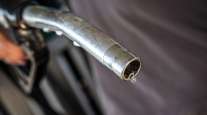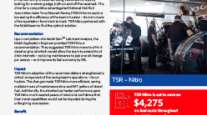Diesel Again Tops $4 a Gallon After 2.3¢ Rise
This story appears in the Nov. 28 print edition of Transport Topics.
The average price of a gallon of diesel climbed above $4 last week, approaching levels not seen since spring, when trucking’s main fuel stayed over that benchmark for six weeks.
Diesel cost an average of $4.010 a gallon, up 2.3 cents from $3.987 the previous week, the Department of Energy said after its Nov. 21 weekly survey of filling stations nationwide.
Gasoline prices, meanwhile, fell 6.8 cents on average last week, dropping to $3.368 from $3.436.
Higher diesel prices may reflect a strengthening economy, but for truckers still struggling to regain pre-recession profitability, $4 fuel means paying about 26%, or nearly 84 cents, more a gallon than a year ago when the average price was $3.171.
“It’s very, very frustrating that . . . in this climate, that fuel prices have gone through such a spike,” said Jay Smith, president of Cox Transportation Services Inc., a dry-van and flatbed carrier in Ashland, Va.
“I’m in the camp that, if the price of fuel goes up too much, it’s going to kill the economy,” Cox said.
Neil Gamson, an economist for the Energy Information Administration at DOE, said, “The bottom line is: Global demand is strong for diesel, stocks are low in much of the U.S. and it’s the heating season, too.”
With the peak driving season over for everyone but truckers, falling gasoline prices reflect a lessening demand and gasoline stocks are plentiful, Gamson said.
By comparison, distillate inventories that support diesel production are down in most regions of the country, Gamson said. Ironically, large quantities of distillate are headed to North Dakota to support the booming oil industry there, he added.
The latest DOE report on distillate inventories shows that, as of Nov. 11, U.S. stocks were down from a year ago, standing at 133.7 million barrels compared with 158.8 million barrels at the corresponding time in 2010 and 167.4 million barrels in 2009.
The global demand for diesel also is increasing as China and other emerging economies grow, Gamson said.
“And we still have the issue of Japan. . . . The [nuclear power plants] have not come back, so they’re burning distillate fuel, and I guess some [liquefied natural gas] in their backup generators,” he said.
At Cox Transportation, a general freight and flatbed fleet that runs about 140 tractors, managers try to control fuel costs with the same fuel-saving strategies as most trucking firms, Smith said.
“We spec our trucks with all the aerodynamic stuff that it has,” Smith said. “We run low-rolling-resistance tires, that type of thing,” he said.
The carrier also depends on fuel surcharges to recoup fuel costs, although the surcharge never fully covers a carrier’s costs, Smith said.
“When fuel prices are going up really fast, as they have been recently, it really hurts because you’re charging a fuel surcharge based on last week’s price, but you’re paying this week’s price.”
Glory Transportation Inc., a refrigerated fleet in Fayetteville, Ark., is holding down fuel costs by purchasing cooperatively through the National Association of Small Trucking Companies.
“We buy better than we would if we were just literally buying at the pump,” said Tom Doty, who with his wife Karen, owns Glory and its sister company, Spirit Logistics LLC.
NASTC is “really aimed at smaller carriers like ourselves that just don’t have the volume to drive good pump pricing,” said Doty, whose two firms together own 10 tractors and 75 trailers.
“We buy more aerodynamic tractors than we would have 10 years ago,” he said of another fuel-saving strategy. “We don’t buy any square-nose tractors anymore because they’re less fuel- efficient.”
The carrier also has auxiliary power units on all its units, “so we don’t have to idle the big trucks,” Doty said.
With drivers on the road for days at a time and having to rest 10 hours at a stretch in hot or cold climates, the APUs have proven themselves as fuel savers, he said.
“A big truck will use a little over a gallon an hour, and an APU will use a little over a gallon in 10 hours,” Doty said.
Currently, crude oil prices in the United States, which sometimes strictly dictate pump prices, have had less to do with diesel prices than winter’s approach and falling distillate stockpiles, said Chris Barber, a crude oil market specialist in the Wakefield, Mass., office of Energy Security Analysis Inc.
The price of crude oil settled on the New York Mercantile Exchange at $98.01 a barrel on Nov. 22. A week earlier the price closed at $99.37.




